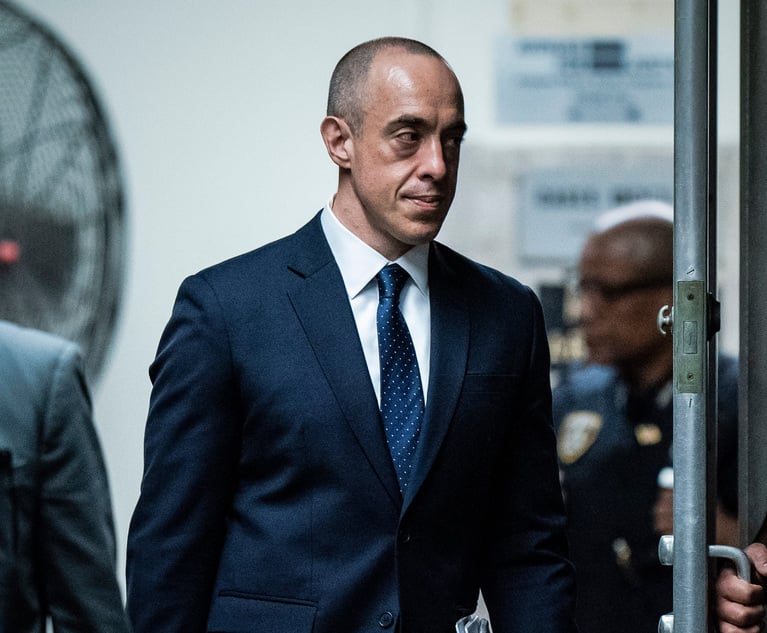Tyco and 3M Ask for MDL Treatment in Dozens of Firefighting Foam Lawsuits
The lawsuits come on the heels of a $670.7 million settlement with DuPont and Chemours Co. last year involving an MDL over a related chemical that has been linked to cancer and hypertension in pregnant women and other illnesses.
October 02, 2018 at 02:50 PM
5 minute read
 Photo: Shutterstock
Photo: Shutterstock
Manufacturers of foams used to fight fuel fires have asked to coordinate about 85 lawsuits that allege toxic chemicals in their products have leaked into drinking water, putting residents at risk of getting cancer and other illnesses.
In a motion filed last week, Tyco Fire Products LP and Chemguard Inc. asked the U.S. Judicial Panel on Multidistrict Litigation to send 75 cases to Massachusetts, where a federal judge is overseeing four actions “well into the litigation process.” The cases span seven states: Colorado, Delaware, Florida, Massachusetts, New York, Pennsylvania and Washington. 3M Co. filed a motion two days later to add nine more lawsuits from Alabama, Michigan, Minnesota and upstate New York.
The motions come after a federal judge in Colorado issued a Sept. 25 order in a class action brought on behalf of 64,000 residents of communities near Colorado Springs. They claim chemicals from the foam—referred to in court papers as aqueous film-forming foams—at the Peterson Air Force Base and the Colorado Springs Municipal Airport have leaked into their drinking water, causing pregnancy problems and kidney and thyroid diseases. They are seeking a medical monitoring fund and compensation for lost property values.
Plaintiffs in that case have filed a class certification motion, which the manufacturers have opposed. The motion goes before U.S. District Judge R. Brooke Jackson of the District of Colorado on Nov. 30—one day after the MDL panel's next hearing in New York.
“This is a case we've been aggressively litigating for two years now,” said Hunter Shkolnik, whose New York firm, Napoli Shkolnik, is involved in a large share of the foam cases, including the Colorado class action. “And, on the eve of a class certification in Colorado, the defendants are doing everything in their power to remove the case from Judge Jackson. And it's nothing more than forum shopping.”
Stephen Raber, a partner at Williams & Connolly in Washington, D.C., filed the motion on behalf of Tyco and Chemguard, both part of Johnson Controls. He did not respond to a request for comment.
Fraser Engerman, a spokesman for Johnson Controls, said in a statement: “Tyco and Chemguard acted appropriately and responsibly in connection with products containing PFOA, including aqueous film forming foams (AFFFs). AFFFs have prevented catastrophic fires and saved many lives, which is why the U.S. military and fire-fighting professionals have chosen to use them for decades and continue to use them today.”
3M attorney Timothy Bishop, a partner at Mayer Brown in Chicago, did not respond to a request for comment.
The lawsuits come on the heels of a $670.7 million settlement with DuPont and Chemours Co. last year involving multidistrict litigation over a related chemical, C8, a type of perfluorooctanoic acid, or PFOA, used to make Teflon and other household items that has been linked to cancer, hypertension in pregnant women and other illnesses.
The new cases focus primarily on foams used at military bases, airports and other sites to fight fuel fires. In 2016, the Environmental Protection Agency issued recommendations on the safe level of those chemicals in drinking water.
Among the New York sites referenced in the complaints are New York Stewart International Airport, Stewart Air National Guard Base, Francis S. Gabreski Airport and East Hampton Airport. Pennsylvania sites involve the Naval Air Station Joint Reserve Base Willow Grove and the Naval Air Warfare Center in Warminster. Two separate complaints mention New Castle Airport in Delaware and Pensacola International Airport in Florida.
Other defendants include National Foam Inc., Buckeye Fire Equipment Co. and United Technologies Corp.'s Kidde division. In a few cases, the defendants include local governments, and a case brought by the city of Newburgh, New York, names the U.S. government, U.S. Department of Defense and U.S. Air Force. In their Sept. 25 motion, Tyco and Chemguard said they anticipated asserting a “governmental contractor defense.”
The cases are a hodgepodge of class actions, individual personal injury lawsuits and actions brought by water districts and other municipal entities. But Tyco and Chemguard want all of them in the same MDL.
“The panel has almost always found that centralization is appropriate in purported environmental contamination cases—including cases involving one of the chemicals at issue in this litigation, PFOA,” Raber wrote, citing the C8 cases.
3M's motion, filed on Sept. 27, addressed a separate set of cases involving products sold to third parties or manufactured at its own facilities. In its motion, 3M said more than 100 additional cases are pending in state courts in Alabama and Michigan. In February, 3M agreed to pay $850 million to settle a case by the state of Minnesota over water pollution from its manufacturing plant.
Both motions asked to send the cases to U.S. District Judge Denise Casper, who on Dec. 18 dismissed some of the claims in a case brought by Barnstable County, Massachusetts, alleging water contamination from the Barnstable County Fire Rescue Training Academy. As an alternative, they suggest U.S. District Judge Kenneth Karas in the Southern District of New York, who is overseeing four cases, including the city of Newburgh's case.
The motions come after Jackson ruled against the defendants in the Colorado class action, concluding that the Colorado Supreme Court “would probably recognize a claim for medical monitoring absent present physical injury.” But he agreed that the complaint lacked specifics about medical testing, so he dismissed the medical monitoring claims so that plaintiffs could amend the complaint.
On Monday, Jackson denied a motion the defendants filed to stay the Colorado class action.
In addition to the class action, nearly 7,000 individuals alleging personal injuries have brought more than 40 cases in Colorado that would be part of an MDL, if granted.
This content has been archived. It is available through our partners, LexisNexis® and Bloomberg Law.
To view this content, please continue to their sites.
Not a Lexis Subscriber?
Subscribe Now
Not a Bloomberg Law Subscriber?
Subscribe Now
NOT FOR REPRINT
© 2025 ALM Global, LLC, All Rights Reserved. Request academic re-use from www.copyright.com. All other uses, submit a request to [email protected]. For more information visit Asset & Logo Licensing.
You Might Like
View All
'Something Else Is Coming': DOGE Established, but With Limited Scope

Supreme Court Considers Reviving Lawsuit Over Fatal Traffic Stop Shooting

US DOJ Threatens to Prosecute Local Officials Who Don't Aid Immigration Enforcement
3 minute read
US Judge Cannon Blocks DOJ From Releasing Final Report in Trump Documents Probe
3 minute readTrending Stories
Who Got The Work
J. Brugh Lower of Gibbons has entered an appearance for industrial equipment supplier Devco Corporation in a pending trademark infringement lawsuit. The suit, accusing the defendant of selling knock-off Graco products, was filed Dec. 18 in New Jersey District Court by Rivkin Radler on behalf of Graco Inc. and Graco Minnesota. The case, assigned to U.S. District Judge Zahid N. Quraishi, is 3:24-cv-11294, Graco Inc. et al v. Devco Corporation.
Who Got The Work
Rebecca Maller-Stein and Kent A. Yalowitz of Arnold & Porter Kaye Scholer have entered their appearances for Hanaco Venture Capital and its executives, Lior Prosor and David Frankel, in a pending securities lawsuit. The action, filed on Dec. 24 in New York Southern District Court by Zell, Aron & Co. on behalf of Goldeneye Advisors, accuses the defendants of negligently and fraudulently managing the plaintiff's $1 million investment. The case, assigned to U.S. District Judge Vernon S. Broderick, is 1:24-cv-09918, Goldeneye Advisors, LLC v. Hanaco Venture Capital, Ltd. et al.
Who Got The Work
Attorneys from A&O Shearman has stepped in as defense counsel for Toronto-Dominion Bank and other defendants in a pending securities class action. The suit, filed Dec. 11 in New York Southern District Court by Bleichmar Fonti & Auld, accuses the defendants of concealing the bank's 'pervasive' deficiencies in regards to its compliance with the Bank Secrecy Act and the quality of its anti-money laundering controls. The case, assigned to U.S. District Judge Arun Subramanian, is 1:24-cv-09445, Gonzalez v. The Toronto-Dominion Bank et al.
Who Got The Work
Crown Castle International, a Pennsylvania company providing shared communications infrastructure, has turned to Luke D. Wolf of Gordon Rees Scully Mansukhani to fend off a pending breach-of-contract lawsuit. The court action, filed Nov. 25 in Michigan Eastern District Court by Hooper Hathaway PC on behalf of The Town Residences LLC, accuses Crown Castle of failing to transfer approximately $30,000 in utility payments from T-Mobile in breach of a roof-top lease and assignment agreement. The case, assigned to U.S. District Judge Susan K. Declercq, is 2:24-cv-13131, The Town Residences LLC v. T-Mobile US, Inc. et al.
Who Got The Work
Wilfred P. Coronato and Daniel M. Schwartz of McCarter & English have stepped in as defense counsel to Electrolux Home Products Inc. in a pending product liability lawsuit. The court action, filed Nov. 26 in New York Eastern District Court by Poulos Lopiccolo PC and Nagel Rice LLP on behalf of David Stern, alleges that the defendant's refrigerators’ drawers and shelving repeatedly break and fall apart within months after purchase. The case, assigned to U.S. District Judge Joan M. Azrack, is 2:24-cv-08204, Stern v. Electrolux Home Products, Inc.
Featured Firms
Law Offices of Gary Martin Hays & Associates, P.C.
(470) 294-1674
Law Offices of Mark E. Salomone
(857) 444-6468
Smith & Hassler
(713) 739-1250










